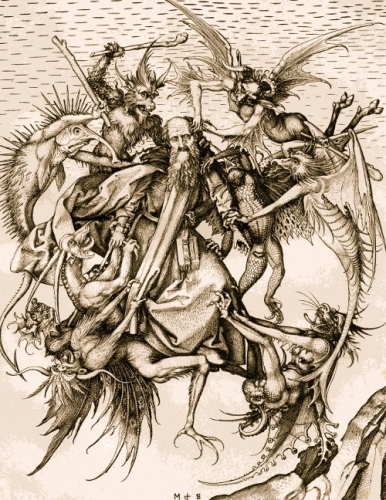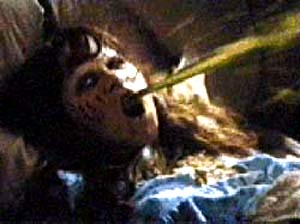Occultural Studies 3.0: Devil's Switchboard
Demonology is not simply the study of demons, but of noise's assault on signal - a media theory avant la lettre, writes Eugene Thacker
According to Socrates, it was a demon that prevented him from entering a career in politics:
It began in my early childhood - a sort of voice which comes to me, and when it comes it always dissuades me from what I am proposing to do [...] It is this that debars me from entering public life, and a very good thing too, in my opinion, because you may be quite sure, gentlemen, that if I had tried long ago to engage in politics, I should long ago have lost my life, without doing any good either to you or to myself.'i
While we may thank Socrates for listening to his demon, the demon's presence is not some miraculous event, but an everyday phenomenon; the daimon is always by his side, and it obtains a strange intimacy, always keeping him company, and, in this case at least, providing good advice.

Image: Still from William Friedkin's The Exorcist, 1973
But aside from Socrates, we hear little about the demons of other philosophers. Perhaps this is because philosophers, being reliant on their principles of sufficient reason, have no need of a companion-demon. The second a demon appears to Descartes in the midst of his Meditations, it is just as quickly dismissed by him. With this in mind, let us begin with the following: while philosophers have spent much time debating the opposition between being and non-being, theology spends its time thinking about inbetween being, intermediary being, or being-in-the-middle.
For theologians such as Aquinas, such intermediary beings, such as angels, served an important function: they not only provided a conceptual and doctrinal guarantee that there was indeed a reliable connection between the earthly and the divine, but they also served to manage, govern, and mediate that boundary itself. While God may forever lie beyond the pale of human comprehension, and while human beings are, well, just all-too-human, it is in that middle zone of angels, demons, and other ‘spiritual creatures' that everything happens. Early Judeo-Christian theology, with its complicated amalgam of pagan and Neoplatonic influences, imagines a whole cosmology, a ‘celestial hierarchy' extending from the divine itself to the lowliest worm that feeds on corpses. Angels (angelos) are by definition messengers and mediators; sometimes they actually deliver messages from the enigmatic muteness of God to chattering, noisesome human beings, and at other times they simply serve to govern the boundary between earth and the heavens - an angel of protection, an angel of vengeance, a recording angel...
This is all well and good for the orthodox and the faithful. But what happens when the intermediary beings fail to mediate? Or when they refuse to mediate? What happens when they negate the very act of mediation, in a kind of negative mediation? This of course is the story of the fallen angels. So for every angel, upholding and governing the order of the cosmos, there is an anti-angel that perturbs, destroys, and disorders; for every angelology there is also a demonology. Demonology is, on a historical level, part and parcel of the long, dark history of persecutions, inquisitions, and witch hunts in early modern Europe. As a field of study it was less given to metaphysical speculation and more to the pragmatic task of defining, classifying, and demonising activities that were deemed heretical to the Church. That said, treatises of demonology - many of them written as how-to manuals by inquisitors - also contain within them a fascinating set of concepts concerning communication and noise, connection and disconnection, mediation and anti-mediation.
It is this context that I find Armando Maggi's book Satan's Rhetoric: A Study of Renaissance Demonology of great interest. Maggi has written a great deal on demonology, and he can be counted among a current generation of scholars who are interested in the political and philosophical aspects of demonology.ii But I should also say that I'm ‘mis-reading' Maggi's book a little. His focus is on the way in which demonology treatises interpret demonic possession through the lens of language, rhetoric, and performativity. Maggi's over-arching question is deceptively simple: if angels are messengers of the word of God, then whose words do demons speak? For Maggi, demons do not deliver anyone's message; they do not speak anyone's voice. In the extreme example of demonic possession, the demon is the communication of noise, the mediation of nothingness:
Like a flame burning everything it encounters [...] demonic language utters chaos and annihilation [...] If a good angel is the linguistic statement connecting a speaker with his interlocutor, a devil is the memorial of a perennial exclusion from meaning.iii
If divine beatitude is the culmination of religious subjectivity, ascending towards a union with the divine (that is, towards total immersion, total immediacy), then demonic possession is the dissolution of the subject, its scattering and dissipation (an absolute disconnect, total opacity, total inaccessibility). In this regard I read Maggi's emphasis on language, rhetoric and performance in a wider context - that of media, mediation, and the current obsession with global connectivity, the absolutism of sharing, and total accessibility.
Maggi's book also avoids the usual analyses of well-known texts, such as the Malleus Maleficarum, and the well-worn approaches to the topic based on race and gender. Instead, he focuses on equally important but underrated works, such as Sylvestro Mazzolini da Prierio's De Strigimagarum Daemonumque Mirandis (1521), the compendium book Thesaurus Exorcismorum (1608), and the ambivalent mystical experiences of Maria Maddalena de'Pazzi. Maggi may not realise it, but the treatises he discusses, with all their concerns over language, communication and connection with the supernatural, make for some very interesting media theories.

Image: Martin Schongauer, St. Anthony Tormented By Demons, ca. 1470-75
A case in point is Prierio's De Strigimagarum. Prierio was a Catholic theologian and Dominican monk. In the early 16th century, he served as an inquisitor in Lombardy, during which time he was named Master of the Sacred, an appointment he held until his death. A papal favorite, Prierio was engaged in a series of attacks and criticisms against Luther. Like many demonology treatises of the time, De Strigimagarum is concerned with both theoretical and practical matters - formulating a coherent theory of demons and demonic activity, and outlining a series of procedures for the detection and punishment of such activity.
Maggi highlights this treatise because in it, demonic possession is not the mysterious and sudden eclipse of a human subject, body and soul. Instead, Prierio posits a method by which the demon possesses, or speaks through, the human being. Drawing on Augustinian theories of the speech of angels, as well as Thomistic theories on the analogy between angelic intelligences and human cognition, Prierio suggests that there is an order and a code to demonic possession in which the demon utilises logic as a way of invading the human being. For Aquinas, angels traditionally manifest themselves via certain signs that human beings can read. These include the apprehension of visions and voices, as well as the witnessing of unusual phenomena in nature. The movement is a unilateral one, from a God beyond speech and silence, to the mediations of angels, who produce a ‘language' that human beings can read, thereby indirectly connecting the human to the divine. By reading these signs backwards, with, of course, the right kind of scriptural and theological knowledge, one could affirm communication with supernatural creatures, while also decoding their divine messages.
The demon's logic is, of course, a perverted logic. For Prierio, demons are also concerned with communication with the human being, though their motives are quite different. Demons do make contact with the human, and they do attempt to express themselves through signs, codes, and symptoms. But while angels were understood to manifest the divine presence (‘messengers of God'), demons neither have a God whose message they are delivering, nor, for that matter, a coherent message that would benefit, assist, or caution the human subject. For the possessed, all that remains is the inability to speak, a mouth that doesn't utter words but that vomits, and a language of non-sense and babbling. In short, the mediation of demons is that of hyper-communication (babbling, nonsense, speaking in tongues), the unspeakable body (convulsions, vomiting, self-mutilation), or silence (melancholy, catatonic states). Demons do mediate, but in a negative or contradictory way.
As an inquisitor, Prierio was concerned with the pragmatic aspects of demonic activity, a concern already outlined in treatises such as the Malleus Maleficarum: how can one identify a case of demonic possession? What signs should one look for? If demonic activity is suspected but not proven, how can one bring out the demon into the open? As Maggi shows, Priero (borrowing from Aristotle and Aquinas), focuses on the syllogism as the way in which demons possess the human being. Just as the syllogism uses the conclusio to connect the universality of the praemissa maior and the concreteness of the praemissa minor (as in the famous ‘therefore Socrates is mortal...' example), so is it the function of the angels to connect the transcendence and unity of God to the fragmented and fallen nature of the human. As Aquinas notes, ‘to go from one extreme to the other it is necessary to pass through the middle.'
In Prierio's theory, demons intercept messages, re-direct and modify them, and sometimes mimic the language of both human and angel. One is tempted to say it: while angels ensure effective and clear communication, demons insert noise into the system; if angels are systems adminstrators, then demons are hackers. The picture Prierio creates is of a whole invisible layer between the earthly and the divine, with words, images, memories, prayers, and phantasms projected and directed between the human and God, with angels sorting and filtering the messages. It is in this middle layer, this preternatural ether, that demons intervene. In fact, Prierio even goes so far as to postulate that demons occupy the air, and this allows them to be formless and metamorphic, to be carried along on the wind and to become any form and any shape. Maggi concisely summarises Prierio's theory of demons:
The medium of the devil's conclusio is the air [...] The air signifies the devils' ‘ungroundedness' [...] a devil can either ‘move the air' to reproduce a specific human idiom, or he can ‘move the air' to shape a bodily figure through which he can have sexual intercourse with a creature.iv
This strange mixture of corporeal (anti)communication is also found in another of the texts Maggi considers, the Thesaurus Exorcismorum, compiled and published in 1608. While the Malleus Maleficarum established demonology as an official practice in theological, political and juridical terms, the Thesaurus provided the blueprint for the central technique of inquisitors and priests - the exorcism. The Thesaurus is actually composed of a set of individual treatises, with titles such as Fustus Daemonum, Flagellum Daemonum, Dispersio Daemonum, and Fuga Satanae, all composed in the late-16th century, and comprising an imposing tome of over a thousand pages.

Image: Vomit from beyond
The Thesaurus is first and foremost a practical manual, with the primary aim of making present that which is hidden. As Maggi notes, demons ‘speak in order to subtract presence from the world.'v Demons manifest their presence only through negation, withdrawal, and obfuscation. It is because of this that the exorcism is significant - it aims to force the presence of an absence, to clarify the obscure. The inquisition itself, directed towards the suffering and tortured body of the possessed subject, also carried out its investigation on the level of language, signs and codes - names and incantations, remembrances and confessionals, cries and sobs. Speech must be substituted for silence.
The Thesaurus provides a framework for this spectacle of divine sovereignty, precisely situating the demonic vis-à-vis the divine. One of the treatises in the Thesaurus is clear on this point:
Threefold is language. The first kind is the language of deed; the second of the voice; and the third is of the mind. God speaks with the language of deed. Human beings speak with the language of the voice, and angels speak with the language of the mind.vi
The level of voice (the human) becomes the battleground where the exorcist must separate human from non-human utterances, and distinguish authentic human language from the simulacra of the demon. Whether through external signs (strange behaviour, cold chills, sudden pain, convulsions) or through internal signs (strange thoughts, words, or phrases in the mind), the demon is adept at embodying and performing the language of the voice, and at performing the human itself. Indeed, sometimes the external and internal signs become one and the same, as with one exorcism Maggi mentions, in which the exorcist gives the possessed person a potion of herbs, vinegar and olive oil, exorcising the potion with the words ‘I exorcise you, natural blend, which is able to induce vomit, in the name of God the Almighty, creator of your healing virtue...' Drawing an analogy to the parable of Jonah and the whale, the exorcism commands the possessed human subject to enunciate the name of the demon in the act of vomiting. The demon's name is hurled forth, and, at least in this case, communication is synonymous with vomit. This is emblematic of many of the texts Maggi discusses - a form of demonic mediation that manifests itself at once through negation and absence (the demons never speak in their own voice, never show their face), and yet through what Georges Bataille once called a ‘base materialism,' one of bodily fluids and divine vomit.
Today, we no longer believe in demons. Our global, networked cultures are at once too religiously fanatical and too hyper-rational to allow for the kind of cosmologies thought up by early modern demonologists. We do, however, like to remind ourselves that demons once existed, and the franchise of the exorcism movie is a testament to this fascination with that in which we no longer believe - from silent film era ‘documenatries' such as Häxan, to Hollywood hits such as The Exorcist, to recent genre films such as The Last Exorcism. However, Maggi's treatment of the topic suggests something different. His analysis of demonology treatises shows us a detailed and nuanced theory of mediation and communication, set within the framework of divine sovereignty.
At its limit, the demon and demonic possession constitute a premodern form of anti-humanism: ‘For the devil, an act of knowledge is always equivalent to an act of annihilation'.vii In Maggi's hands, demons are far from anthropomorphised and psychologised tempters or tricksters. They are identical with the elemental sphere, with the materiality of words, signs and codes, with the enigmatic, tempestuous and sometimes malefic non-human world. Demons and demonic possession in this sense are not about the subject and its always-fragile boundaries, and they are not about the human (or posthuman - the human through the side-door); instead demons are a stand-in for the limits of our ability to comprehend the world, either in terms of the human or the divine. ‘By reading natural signs (winds, clouds, animals' expressions), devils are able to bring about storms, plagues and floods. Moreover, by reading a human being's gestures, facial expressions, linguistic intonation, a devil can produce a ‘discourse' able to erase that human being's soul and body.'viii
Eugene Thacker <thackere AT newschool.edu> is a New York based writer and the author of Horror of Philosophy (forthcoming from Zero Books). He teaches at The New School and is a scholar-in-residence at the Miskatonic University Colloquy for Shoggothic Atheology
Info
Armando Maggi, Satan's Rhetoric: A Study of Renaissance Demonology, University of Chicago Press, 2001.
i Plato, Socrates' Defense (Apology), trans. Hugh Tredennick, in Plato: The Collected Dialogues, ed. Edith Hamilton and Huntington Cairns (Princeton University Press, 1989), 31D.
ii In this regard I mention works such as Alain Bourreau's Satan the Heretic, Stuart Clark's Thinking With Demons, Nancy Caciola's Discerning Spirits, and Maggi's In the Company of Demons, as well as the work of scholars such as Richard Kieckhefer and D.P. Walker.
iii Maggi, Satan's Rhetoric: A Study of Renaissance Demonology, p.5.
iv Ibid., p.35.
v Ibid., p.96.
vi From Complementum Artis Exorcisticae, cited in Maggi, p.109.
vii Maggi, p.41.
viii Ibid.
Mute Books Orders
For Mute Books distribution contact Anagram Books
contact@anagrambooks.com
For online purchases visit anagrambooks.com






